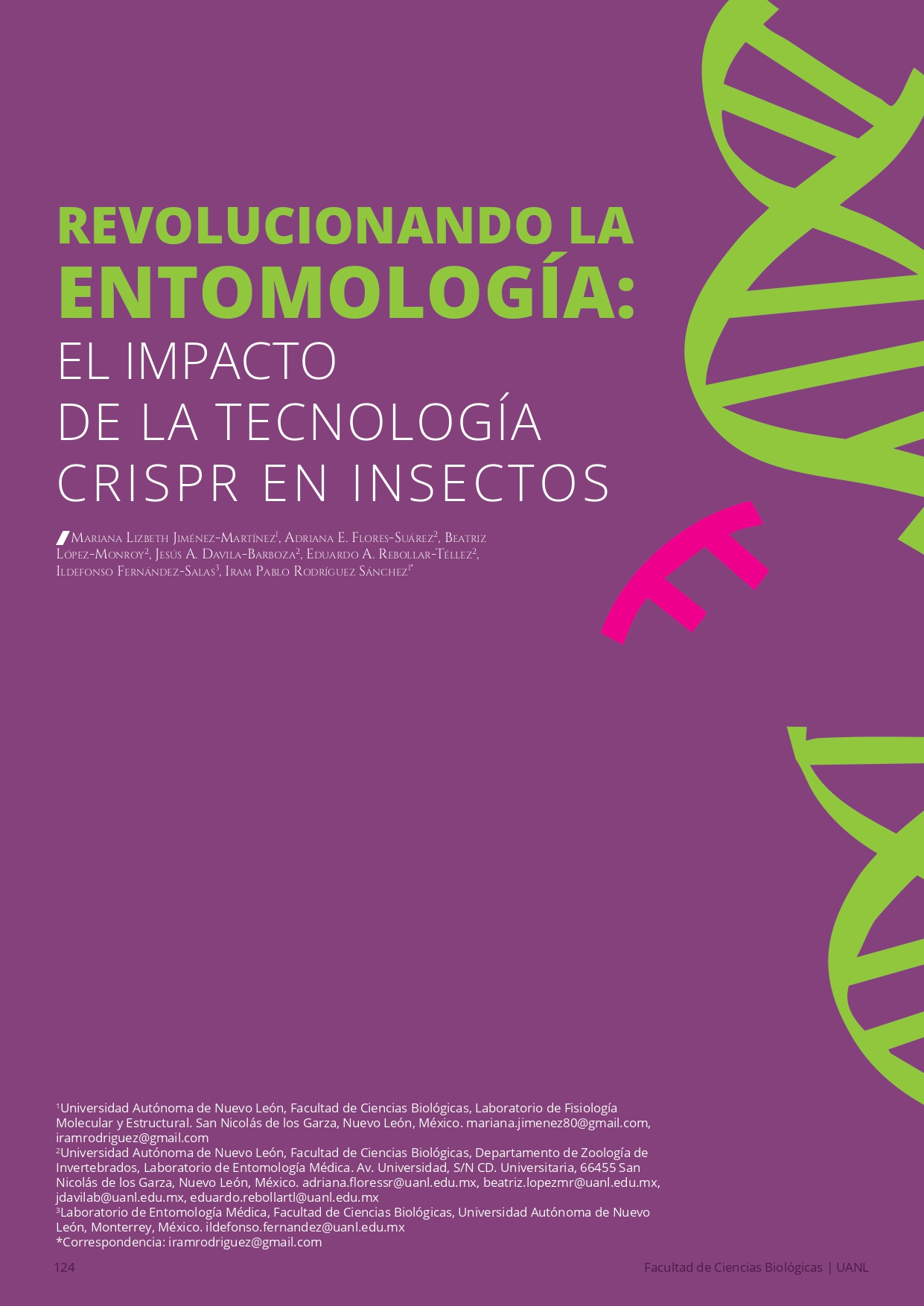Revolucionando la entomología
El impacto de la tecnología CRISPR en insectos
DOI:
https://doi.org/10.29105/bys8.16-199Palabras clave:
CRISPR, Entomología, Edición genómicaResumen
El desarrollo del sistema CRISPR ha marcado un hito en la entomología, al proporcionar una herramienta poderosa para la edición genómica precisa. Esta tecnología ha revolucionado la investigación en insectos, permitiendo estudios detallados sobre funciones genéticas y facilitando el desarrollo de nuevas estrategias de control de plagas. CRISPR ha sido clave en la mutagénesis dirigida de varios insectos, revelando aspectos cruciales de su biología, como la pigmentación, el desarrollo y la metamorfosis. Además, ha abierto nuevas posibilidades para el manejo de plagas mediante la creación de insectos genéticamente modificados capaces de reducir poblaciones de plagas de manera efectiva. La expansión del uso de CRISPR a especies no tradicionales ha permitido avances significativos en su estudio y manejo, mostrando su potencial en áreas como la conservación y el control de artrópodos de importancia médica, veterinaria y agrícola.
Descargas
Citas
Alphey L. 2016. Can CRISPR/Cas9 gene drives curb malaria? Nature Biotechnology. 34: 149-150. https://doi.org/10.1038/nbt.3473 DOI: https://doi.org/10.1038/nbt.3473
Barrangou, R. y Doudna, J. A. 2016. Applications of CRISPR technologies in research and beyond. Nature Biotechnology, 34(9): 933-941. https://doi.org/10.1038/nbt.3659. DOI: https://doi.org/10.1038/nbt.3659
Basu, S., Aryan, A., Overcash, J. M., Samuel, G. H., Anderson, M. A. E., Dahlem, T. J., Myles, K. M. y Adelman, Z. N. 2015. Silencing of end-joining repair for efficient site-specific gene insertion after TALEN/CRISPR mutagenesis in Aedes aegypti. Proceedings of the National Academy of Sciences, 112: 4038-4043. https://doi.org/10.1073/pnas.1502370112 DOI: https://doi.org/10.1073/pnas.1502370112
Cagliari, D., Smagghe, G., Zotti, M., y Taning, C. 2020. RNAi and CRISPR/Cas9 as Functional Genomics Tools in the Neotropical Stink Bug, Euschistus heros. Insects, https://doi.org/10.3390/insects11120838. DOI: https://doi.org/10.3390/insects11120838
Dong, S., Lin, J., Held, N. L., Clem, R. J., Passarelli, A. L. y Franz, A. W. 2015. Heritable CRISPR/Cas9-mediated genome editing in the yellow fever mosquito, Aedes aegypti. PLOS ONE, 10: 0122353. https://doi.org/10.1371/journal.pone.0122353 DOI: https://doi.org/10.1371/journal.pone.0122353
Dong, Y., Simoes, M. L., Marois, E. y Dimopoulos, G. 2018. CRISPR/Cas9-mediated gene knockout of Anopheles gambiae FREP1 suppresses malaria parasite infection. PLOS Pathogens, 14(3), e1006898. https://doi.org/10.1371/journal.ppat.1006898 DOI: https://doi.org/10.1371/journal.ppat.1006898
Gui, S., Taning, C., Wei, D. y Smagghe, G. 2020. First report on CRISPR/Cas9-targeted mutagenesis in the Colorado potato beetle, Leptinotarsa decemlineata. Journal of Insect Physiology, 104013. https://doi.org/10.1016/j.jinsphys.2020.104013. DOI: https://doi.org/10.1016/j.jinsphys.2020.104013
Hammond, A., Galizi, R., Kyrou, K., Simoni, A., Siniscalchi, C., Katsanos, D., Gribble, M., Baker, D., Marois, E., Russell, S., Burt, A., Windbichler, N., Crisanti, A. y Nolan, T. 2015. A CRISPR/Cas9 Gene Drive System Targeting Female Reproduction in the Malaria Mosquito vector Anopheles gambiae. Nature Biotechnology, 34, 78-83. https://doi.org/10.1038/nbt.3439. DOI: https://doi.org/10.1038/nbt.3439
Hsu, P. D., Lander, E. S. y Zhang, F. 2014. Development and applications of CRISPR/Cas9 for genome engineering. Cell, 157(6), 1262-1278. https://doi.org/10.1016/j.cell.2014.05.010. DOI: https://doi.org/10.1016/j.cell.2014.05.010
Jinek, M., Chylinski, K., Fonfara, I., Hauer, M., Doudna, J. A. y Charpentier, E. 2012. A programmable dual-RNA–guided DNA endonuclease in adaptive bacterial immunity. Science, 337(6096), 816-821. https://doi.org/10.1126/science.1225829. DOI: https://doi.org/10.1126/science.1225829
Kotwica-Rolinska, J., Chodáková, L., Chvalová, D., Krištofová, L., Fenclova, I., Provazník, J., Bertolutti, M., Wu, B. y Doležel, D. 2019. CRISPR/Cas9 Genome Editing Introduction and Optimization in the Non-model Insect Pyrrhocoris apterus. Frontiers in Physiology, 10. https://doi.org/10.3389/fphys.2019.00891. DOI: https://doi.org/10.3389/fphys.2019.00891
Koutroumpa, F. A., Monsempes, C., François, M. C., de Cian, A., Royer, C., Concordet, J. P. y Jacquin-Joly, E. 2016. Heritable genome editing with CRISPR/Cas9 induces anosmia in a crop pest moth. Scientific Reports, 6(1), 29620. https://doi.org/10.1038/srep29620. DOI: https://doi.org/10.1038/srep29620
Paulraj, M. G., Ignacimuthu, S. y Reegan, A. D. 2016. Gene silencing and gene drive in dengue vector control: A review. Indian Journal of Natural Products and Resources, 7, 1-8.
Sternberg, S. H. y Doudna, J. A. 2015. Expanding the biologist’s toolkit with CRISPR/Cas9. Molecular Cell, 58(4), 568-574. https://doi.org/10.1016/j.molcel.2015.02.032 DOI: https://doi.org/10.1016/j.molcel.2015.02.032
Wickramasinghe, P. D., Silva, G. N., Silva Gunawardene, Y. I. y Dassanayake, R. S. 2021. Advances in Aedes mosquito vector control strategies using CRISPER/Cas9. Genetically Modified and Other Innovative Vector Control Technologies. Singapore: Springer; pp. 67-87. https://doi.org/10.1007/978-981-16-2964-8_4 DOI: https://doi.org/10.1007/978-981-16-2964-8_4
Zhang, L., Yang, L., Li, H., Yu, Y. y Zhai, J. 2023. Rapid detection of insect pest with CRISPR‐Cas13a‐Based Lateral Flow Strip: Using Locusta migratoria manilensis. Journal of Applied Entomology, 147(6), 416-422. https://doi.org/10.1111/jen.13121 DOI: https://doi.org/10.1111/jen.13121
Zhang, Z., Aslam, A., Liu, X., Li, M., Huang, Y. y Tan, A. 2015. Functional analysis of Bombyx Wnt1 during embryogenesis using the CRISPR/Cas9 system. Journal of Insect Physiology, 79, 73-79. https://doi.org/10.1016/j.jinsphys.2015.06.004. DOI: https://doi.org/10.1016/j.jinsphys.2015.06.004
Zhu, G., Chereddy, S., Howell, J. y Palli, S. 2020. Genome editing in the fall armyworm, Spodoptera frugiperda: Multiple sgRNA/Cas9 method for identification of knockouts in one generation. Insect Biochemistry and Molecular Biology, 103373. https://doi.org/10.1016/j.ibmb.2020.103373. DOI: https://doi.org/10.1016/j.ibmb.2020.103373
Zhu, G., Peng, Y., Zheng, M., Zhang, X., Sun, J., Huang, Y., y Dong, S. 2017. CRISPR/Cas9 mediated BLOS2 knockout resulting in disappearance of yellow strips and white spots on the larval integument in Spodoptera litura. Journal of Insect Physiology, 103, 29-35. https://doi.org/10.1016/j.jinsphys.2017.09.008. DOI: https://doi.org/10.1016/j.jinsphys.2017.09.008







